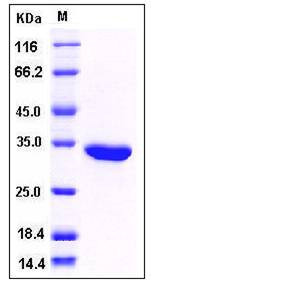E.coli Enoyl-ACP Reductase / FABI Protein (His Tag)
b1288,ECK1283,envM,gts,JW1281,qmeA
- 100ug (NPP2813) Please inquiry
| Catalog Number | P30001-E07E |
|---|---|
| Organism Species | E. coli |
| Host | E. coli |
| Synonyms | b1288,ECK1283,envM,gts,JW1281,qmeA |
| Molecular Weight | The recombinant E.coli FABI consisting of 276 amino acids and has a calculated molecular mass of 29.5 kDa. It migrates as an approximately 33 kDa band in SDS-PAGE under reducing conditions. |
| predicted N | Met |
| SDS-PAGE |  |
| Purity | > 98 % as determined by SDS-PAGE |
| Protein Construction | A DNA sequence encoding the E.coli FABI (NP_287908.1) (Gly 2-Lys 262) was expressed, with a polyhistide tag at the N-terminus. |
| Bio-activity | |
| Research Area | |
| Formulation | Lyophilized from sterile 20mM Tris 0.5M NaCl, 10% glycerol, pH 7.5 1. Normally 5 % - 8 % trehalose and mannitol are added as protectants before lyophilization. Specific concentrations are included in the hardcopy of COA. |
| Background | Enoyl-ACP reductase, also known as NADH-dependent enoyl-ACP reductase and FABI, is a cell inner membrane and peripheral membrane protein which belongs to the short-chain dehydrogenases/reductases (SDR) family and FabI subfamily. Microorganisms produce many kinds of antibiotics which function in an antagonistic capacity in nature where they have much competition. Bacterial FAS provides essential fatty acids for use in the assembly of key cellular components. Among them, FABI is an enoyl-ACP reductase which catalyzes the final and rate-limiting step of bacterial FAS. The antibiotic diazaborine interferes with the activity by binding to the protein. FABI is a potential target for selective antibacterial action, because it shows low overall sequence homology with mammalian enzymes. Various compounds have been reported as inhibitors of bacterial FabI-inhibitory compounds. |
| Reference |
